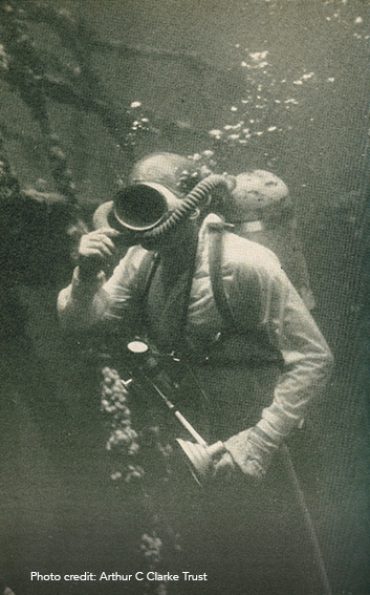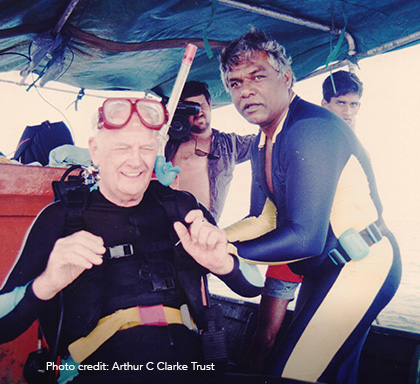Clarke and Undersea
Exploration

The aqua-lung, invented in the mid 1940s, enabled divers to spend extended periods of time underwater. Arthur C Clarke and his friend Mike Wilson (1934 – 1995) were early adopters of this technology. They first explored the Great Barrier Reef off Australia, and then turned their attention to the tropical Indian Ocean around Ceylon (now Sri Lanka).
In 1956, Clarke and Wilson embarked on an expedition of the island and the seas around it. Together with the diver and naturalist Rodney Jonklaas, they found and investigated some 40 shipwrecks, many of them of historical significance.
At the end of their expedition, Clarke and Wilson both decided, independently, to settle down in Ceylon to pursue their own careers.
In the late 1950s, Clarke collaborated with Lankan diver Hector Ekanayake to set up Underwater Safaris, the country’s first professional diving company. They offered tourists a ‘guided diving service’ to coral reefs and shipwrecks both of which the island had in abundance. The company pioneered dive training and underwater tourism in Sri Lanka.
“
Much of my youth was spent on the Minehead beach, exploring rock-pools and building wave-defying battlements. Even now, I feel completely relaxed only by the edge of the sea – or, better still, hovering weightless beneath it, over the populous and polychromatic landscape of my favourite reef. ”
”
– Arthur C Clarke
“
Much of my youth was spent on the Minehead beach, exploring rock-pools and building wave-defying battlements. Even now, I feel completely relaxed only by the edge of the sea – or, better still, hovering weightless beneath it, over the populous and polychromatic landscape of my favourite reef. ”
”
– Arthur C Clarke
In 1958, Clarke and Mike Wilson co-produced the first underwater documentary filmed in Ceylon. Titled Beneath the Seas of Ceylon (25 mins), this 16 mm film was sponsored by the Ceylon Tea Propaganda Board. According to historian Richard Boyle, it featured some breath-taking scenes of Rodney Jonklaas taming large groupers, and then being chased by sharks. There is no trace of this film today.

The last dive, off Colombo, aged 75
Clarke’s interest in diving on shipwrecks led to some pioneering work on maritime archaeology in Sri Lanka.
Although Clarke was affected by Post-Polio Syndrome from the mid 1980s, he found it easier to move in the water than on land. He continued to dive in shallow waters until 1992. In that year, when he was 75 years old, he did his last sea dive on a shipwreck 11 km off the coast of Colombo, Sri Lanka’s commercial capital. Local divers now refer to that site as the Clarke wreck.



